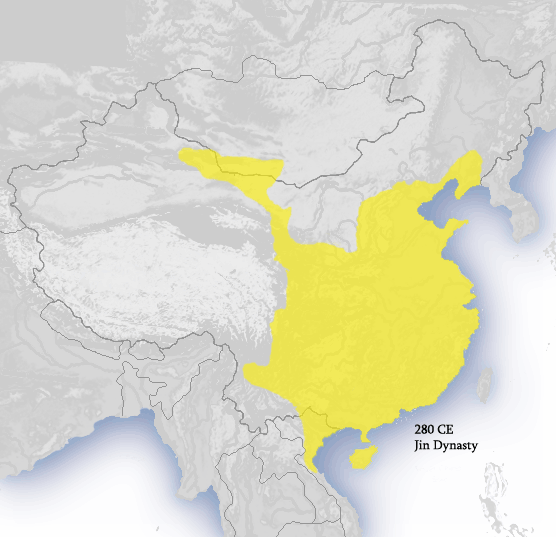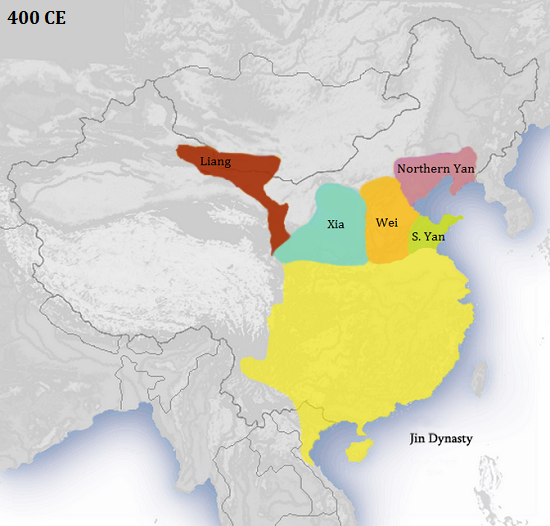Hakka dishes are historic dishes, artefacts from China's ancient Central Plains, centred in today's Henan province. These dishes came to us through five great migrations of Hakka people to the South, a long march starting nearly 2,000 years ago.
Hakka Ancestral Homeland
Hakka people dates back to the reign of the Yellow Emperor 黃帝 2698 - 2598 BC (i.e. nearly 5,000 years ago). Every Spring, Xinzheng city in Henan 河南省新郑市 hosts a ceremony honouring Yellow Emperor, the legendary ancestor of the Chinese nation. Thousands attend the event in Xinzheng including Hakkas from around the world. The portrait of Yellow Emperor on a Republic of China Five Yuan banknote issued in 1912.
Wave One: 300 AD - Fall of Luoyang City to "Barbarians"
At the turn of the fourth century, the Jin 晉 dynasty (266 - 420 AD) weakened by palace power struggles lost ground to invading nomadic tribes at its northern borders.
Between 304 - 316, a wide swathe of northern Jin territory was lost to northern invaders. The invaders captured the Jin dynasty capital of Luoyang 洛陽 (in north Henan) and established five "barbarian" kingdoms in conquered Jin territory.
This forced the Jin dynasty to move south and established its new capital in Jiankang 建康 (today's Nanjing) on the Yangtze River. Naturally, the population in Jin dynasty's lost northern territories followed, thus launching the first wave of Hakka people migration.
From the Yellow River, the proto-Hakka people moved to the Yangtze River, settling in southern Henan, Anhui, Zhejiang, Jiangxi and northern Fujian.
Wave Two: 900 AD - Five Dynasties and Ten Kingdoms Era
The chaos triggered the second wave of Hakka migration further south, this time to southern Anhui, southwestern Jiangxi, southern and western Fujian (near the northern and eastern border of Guangdong province).
Wave Three: 1100 - 1200 AD Fall of Song Dynasty
The Song emperor’s half-brother Gaozong escaped to the south and established the Southern Song dynasty with its capital in Hangzhou 杭州 in Zhejiang province. The third wave of Hakka migration followed the new Song emperor to the south.
After the Jurchens, came the Mongols and by 1279, all of Song dynasty was lost and all of China came under Mongolian rule until 1368.
This forced the Hakka people further south into east and north Guangdong province. Like Tingzhou in Fujian province, Meizhou 梅州 in eastern Guangdong province became a Hakka stronghold. Whereas Tingzhou is known as the "Cradle of Hakka civilisation", Meizhou would become known as the “Hometown of overseas Hakka”. Meizhou is also nicknamed Kezhou 客州 and "Capital of Hakka".
Wave Four: Qing Dynasty Kangxi’s Coastal Clearance Order of 1662
The Ming dynasty ended Mongolian rule in 1368. The Ming dynasty lasted until 1644 when China again fell under nomadic northerners' rule, this time by Manchus. Han Chinese, however, resisted Manchu rule throughout the Qing dynasty era (1644 - 1912).
One Ming loyalist, Zheng Chenggong also known as Koxinga set up his base in Taiwan to raid China's southern coastline. Koxinga was born of a Hakka father and Japanese mother.
Kangxi lifted his coastal evacuation order in 1669 after the threat from Taiwan waned (Koxinga had died of malaria in 1662) and allowed re-population of the shoreline. This triggered the Fourth Wave of Hakka migration as they joined the former residents of the coastline.
During this time, many Hakka from southwestern Jiangxi and northern Guangdong also moved to the central regions of Guangdong, as well as Sichuan, Guangxi, Hunan and Taiwan. Many of these movements were orchestrated by the Manchus to repopulate areas depopulated by wars (life was brutal in those chaotic times).
Wave Five: 1840 - 1940 Out of China
In 1842, the Qing dynasty signed the Treaty of Nanjing which required China to open five ports - Canton (Guangzhou), Amoy (Xiamen), Foochow (Fuzhou), Ningpo (Ningbo), and Shanghai to foreign consuls, traders (i.e. opium), and missionaries. China was also forced to allow its citizens to travel and work abroad (i.e. to facilitate the trading of humans / coolies), thus opening the door for Chinese to emigrate.
In 1851, the Taiping Rebellion broke out, lasting 13 years till 1864. The rebellion was led by Hong Xiuquan, a Hakka Christian fundamentalist as were most of his followers. When the rebellion ended, 20 - 30 million people had died. After quelling the rebellion, the Qing dynasty launched a brutal purge of Hakka in which more people lost their lives.
In the midst of the Taiping Rebellion, another war broke out in south China - the Punti - Hakka Clan Wars 土客械鬥 from 1855 till 1867. It was a horrible time to be in south China.
The root cause was the boiling over of long simmering tensions between locals (Punti) and Hakka over disputes in land distribution, especially following the lifting of Kangxi’s Coastal Clearance Order in 1669. The Punti claimed the fertile plains and shorelines, pushing the Hakka to the hills. The Punti - Hakka Clan Wars left one million dead and many more fleeing for their lives.
Many Hakka fled to British Malaya, Dutch Indonesia, and others to the Americas (ironically, the Punti did the same, thus carrying on the animosity overseas). This led to the Larut Wars in British Malaya between Chinese clans from 1861 to 1874.
Hakka in Singapore
Today, there are around 100 million Hakka around the world with about half living in China.
There are about 200,000 Hakka in Singapore today, forming the fourth largest Chinese community after Hokkien (1.2 million), Teochew (600,000) and Cantonese (400,000).
The Hakka in Singapore were once concentrated around South Bridge Road, Cross Street, North Bridge Road (in Chinatown) and Lorong Tai Seng (in Paya Lebar). Today, Hakka live all over the island.
What can we infer from the long history of migration of Hakka people?
Hakka identity and cohesion are preserved by retaining language and culture (rituals, ceremonies, food, dress, etc) throughout the five phases of migration.
Hakka culture is adaptable, living off the land wherever they are, while allowing them to preserve the core tenets of their identity.
Hakkas have an independent streak that prefer deciding their own destiny rather than to accept subjugation, hence the constant migration (and resistance). Prominent Hakka include Sun Yat Sen, founder of the Republic of China (1912), Deng Xiaoping, architect of China's Open Door policy (1978), Lee Kuan Yew, first Prime Minister of the Republic of Singapore (1965).
Written by Tony Boey on 24 Jan 2022
Reference: Origin and Migration of the Hakkas
Image of Hakka people courtesy of cyberisland. Image of Yellow emperor courtesy of Wikipedia. Map of Five Dynasties and Ten Kingdoms courtesy of Wikipedia. Map of Changting courtesy of Wikipedia. Image of tulou courtesy of Wikipedia. Map of Jin dynasty courtesy of Wikipedia. Map of Yuan dynasty courtesy of Wikipedia. Image of Tulou in Meixian courtesy of Flickr. Image of First Opium War courtesy of Wikipedia. Image of Fuk Tak Chi temple courtesy of Wikipedia. Image of Tiger Balm courtesy of National Archives of Singapore.


















No comments:
Post a Comment
All comments submitted with genuine identities are published